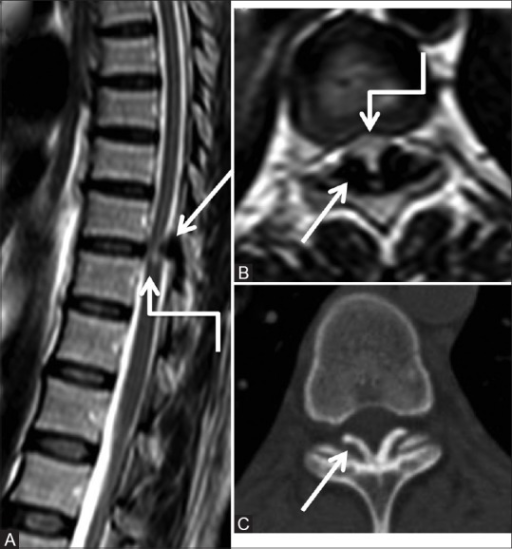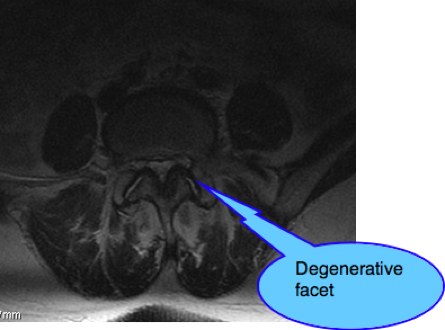Ligamentum Flavum Cyst Mri | The elastin pulls the ligament out of the canal when the spine is extended. Thickening of ligamentum flavum (hypertrophy) can lead to varying degrees of symptoms such as neck pain, back pain, pain radiating down to the arms or legs, numbness, and tingling, inability to stand, walk or lift. Although magnetic resonance imaging (mri) of ligamentum flavum and other spinal cysts have been well described, the role of contrast enhancement in this diagnosis has been neglected. This ligament connects under the facet joints to create a small curtain over the posterior openings between the vertebrae. The histopathological diagnosis was consistent with a ligamentum flavum cyst.
This anatomical term is usually found on spinal mri reports, particularly those detailing a disc pathology. Thickening of ligamentum flavum (hypertrophy) can lead to varying degrees of symptoms such as neck pain, back pain, pain radiating down to the arms or legs, numbness, and tingling, inability to stand, walk or lift. We describe such a case and correlate the mri findings with the histopathology. Nizamani11 mentioned that ligamentum flavum cysts may be difficult to diagnose on mri, as the usual mri images are focused on the. Ligamentum flavum cysts must be differentiated from the synovial or ganglion cysts which are common lesions occurring in the facet joints 12,13,14.

This page is about ligamentum flavum hypertrophy mri,contains imaging in spinal posterior epidural space lesions: On mri, which is the method of choice for the investigation, they are depicted as epidural cystic lesions adjacent to a ligament flavum that may be. Haemorrhagic lumbar juxtafacet cyst with ligamentum flavum. Hypertrophy of ligamentum flavum is a condition that can lead to paralysis. Assessment of traumatic brain injury assessment. Lumbar computerized tomography and magnetic resonance imaging demonstrated an extradural cystic. The ligamenta flava (singular, ligamentum flavum, latin for yellow ligament) are a series of ligaments that connect the ventral parts of the laminae of adjacent vertebrae. The elastin pulls the ligament out of the canal when the spine is extended. Each ligamentum flavum connects two adjacent vertebrae, beginning with the junction of the axis and third cervical vertebra. Assessment of traumatic brain injury online course: Occasionally, the cysts are thought to be the origin of back pain. Cysts of the ligamentum flavum, also known as flaval cysts, are classified as a type of degenerative spinal cysts 1, which arise from the ligamentum flavum. This anatomical term is usually found on spinal mri reports, particularly those detailing a disc pathology.
Ligamentum flavum cyst, a cystic lesion adjacent to the lumbar spine, is a rare cause of neurological symptoms and signs. Cysts of the ligamentum flavum, also known as flaval cysts, are classified as a type of degenerative spinal cysts 1, which arise from the ligamentum flavum. We report a case of ganglion cyst of the ligamentum flavum in the cervical spine, presenting as progressive tetraparesis due to severe spinal cord compression. A pictorial essay gala fb, aswani lumbar spinal canal stenosis. Mri showed that the xlif procedure without posterior.

Ligamenta flava (ligamentum flavum) is thin, broad, and long in the cervical spine or the neck. Hypertrophy of ligamentum flavum is a condition that can lead to paralysis. Ligamentum flavum hypertrophy is also known as ligamentum flavum thickening. Ligamentum flavum literally means yellow ligament, and is so known because it has a yellow coloring due to the amount of elastin (a springy type of collagen). Cysts of the ligamentum flavum are uncommon causes of neurologic signs and symptoms and usually are seen in persons over 50 years of age. Ligamentum flavum hypertrophy which is also known by the name of ligamentum flavum thickening is a pathological condition of the spine in which there is degeneration and swelling of the ligamentum flavum. Related online courses on physioplus. We report a case of ganglion cyst of the ligamentum flavum in the cervical spine, presenting as progressive tetraparesis due to severe spinal cord compression. Mri showed that the xlif procedure without posterior. Nizamani11 mentioned that ligamentum flavum cysts may be difficult to diagnose on mri, as the usual mri images are focused on the. Background ligamentum flavum cysts have been rarely described in the literature and are one of the rare causes of neural compression and. This anatomical term is usually found on spinal mri reports, particularly those detailing a disc pathology. Ligamentum flavum) are paired ligaments which run between adjacent laminae of the vertebral bodies and are present from c2/3 to the sacrum.
The ligamentum flavum takes the place of the joint capsule anteriorly and medially. In light of the acuity and degree of incapacitation of the disease. The average thickness of ligamentum flavum is about details: Ganglion cysts of the ligamentum flavum are uncommon degenerative spinal lesions and are mostly encountered in the lumbar spine. Ligamentum flavum literally means yellow ligament, and is so known because it has a yellow coloring due to the amount of elastin (a springy type of collagen).
Assessment of traumatic brain injury online course: It is a latin word means yellow ligament. This anatomical term is usually found on spinal mri reports, particularly those detailing a disc pathology. Ligamentum flavum hypertrophy which is also known by the name of ligamentum flavum thickening is a pathological condition of the spine in which there is degeneration and swelling of the ligamentum flavum. Ligamenta flava (ligamentum flavum) is thin, broad, and long in the cervical spine or the neck. The elastin pulls the ligament out of the canal when the spine is extended. Understanding your mri of the lumbar spine these pictures of this page are about:ligamentum flavum hypertrophy mri. Cysts of the ligamentum flavum, also known as flaval cysts, are classified as a type of degenerative spinal cysts 1, which arise from the ligamentum flavum. Thickening of ligamentum flavum (hypertrophy) can lead to varying degrees of symptoms such as neck pain, back pain, pain radiating down to the arms or legs, numbness, and tingling, inability to stand, walk or lift. Ligamentum flavum cyst, a cystic lesion adjacent to the lumbar spine, is a rare cause of neurological symptoms and signs. We describe such a case and correlate the mri findings with the histopathology. The average thickness of ligamentum flavum is about details: Mri showed that the xlif procedure without posterior.
Hypertrophy of ligamentum flavum is a condition that can lead to paralysis ligamentum flavum mri. Although magnetic resonance imaging (mri) of ligamentum flavum and other spinal cysts have been well described, the role of contrast enhancement in this diagnosis has been neglected.
Ligamentum Flavum Cyst Mri: This ligament connects under the facet joints to create a small curtain over the posterior openings between the vertebrae.
0 Komentar:
Post a Comment